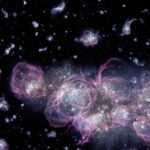What would be the ultimate solution to the energy problems of an advanced civilization? Renowned British American physicist Freeman Dyson theorized it would be a shell made up of mirrors or solar panels that completely surrounds a star — harnessing all the energy it produces.
“One should expect that, within a few thousand years of its entering the stage of industrial development, any intelligent species should be found occupying an artificial biosphere which completely surrounds its parent star,” wrote Dyson in a 1960 paper in which he first explained the concept.
If it sounds like science fiction, that’s because it is: Dyson took the idea from Olaf Stapledon’s 1937 novel “Star Maker,” and he was always open about that. The late scientist was a professor emeritus at the Institute of Advanced Study in Princeton, New Jersey.
Still, coming from a thinker who some in the scientific community say might have been worthy of a Nobel Prize early in his career, the concept took hold and the hypothetical megastructures became known as Dyson spheres, even though the physicist later clarified that they would actually consist of “a loose collection or swarm of objects traveling on independent orbits around the star.”
In his paper, Dyson also noted that Dyson spheres would give off waste heat detectable as infrared radiation, and suggested that looking for that byproduct would be a viable method for searching for extraterrestrial life. However, he added that infrared radiation by itself would not necessarily mean extraterrestrial intelligence, and that one of the strongest reasons for searching for such sources was that new types of natural astronomical objects might be discovered.
“Scientists (at the time) were largely receptive, not to the likelihood that alien civilisations would be found to exist, but that a search for waste heat would be a good place to look,” said George Dyson, a technology writer and author and the second of Dyson’s six children, via email. “Science fiction, from ‘Footfall’ to ‘Star Trek,’ took the idea and ran with it, while social critics adopted the Dyson sphere as a vehicle for questioning the wisdom of unlimited technological growth.”
The elder Dyson himself argued, “It would be much more rewarding to search directly for intelligence, but technology is the only thing we have any chance of seeing.”
In the 1960s, there was no way to actually search for Dyson spheres, but in more recent times many researchers have looked for them, including those at the SETI Institute, a nonprofit organization with a mission to search for extraterrestrial intelligence, and Fermi National Accelerator Laboratory, known as Fermilab. Now, a new study that looked at 5 million stars in the Milky Way galaxy suggests that seven candidates could potentially be hosting Dyson spheres — a finding that’s attracting scrutiny and alternate theories.












